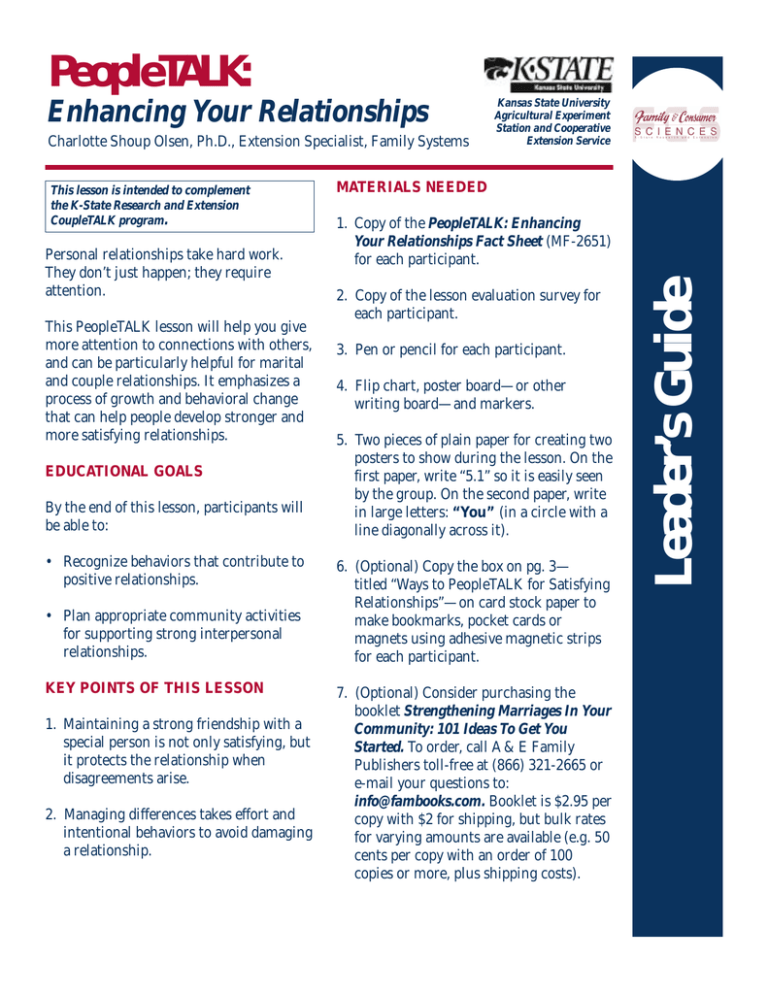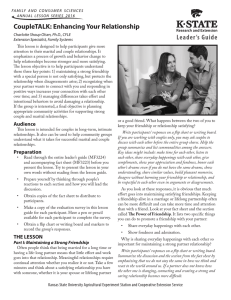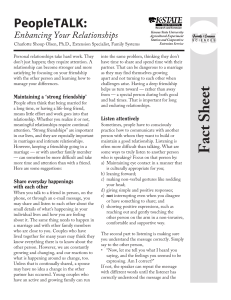
PeopleTALK:
Enhancing Your Relationships
Charlotte Shoup Olsen, Ph.D., Extension Specialist, Family Systems
Personal relationships take hard work.
They don’t just happen; they require
attention.
This PeopleTALK lesson will help you give
more attention to connections with others,
and can be particularly helpful for marital
and couple relationships. It emphasizes a
process of growth and behavioral change
that can help people develop stronger and
more satisfying relationships.
EDUCATIONAL GOALS
By the end of this lesson, participants will
be able to:
• Recognize behaviors that contribute to
positive relationships.
• Plan appropriate community activities
for supporting strong interpersonal
relationships.
KEY POINTS OF THIS LESSON
1. Maintaining a strong friendship with a
special person is not only satisfying, but
it protects the relationship when
disagreements arise.
2. Managing differences takes effort and
intentional behaviors to avoid damaging
a relationship.
MATERIALS NEEDED
1. Copy of the PeopleTALK: Enhancing
Your Relationships Fact Sheet (MF-2651)
for each participant.
2. Copy of the lesson evaluation survey for
each participant.
3. Pen or pencil for each participant.
4. Flip chart, poster board—or other
writing board—and markers.
5. Two pieces of plain paper for creating two
posters to show during the lesson. On the
first paper, write “5.1” so it is easily seen
by the group. On the second paper, write
in large letters: “You” (in a circle with a
line diagonally across it).
6. (Optional) Copy the box on pg. 3—
titled “Ways to PeopleTALK for Satisfying
Relationships”—on card stock paper to
make bookmarks, pocket cards or
magnets using adhesive magnetic strips
for each participant.
7. (Optional) Consider purchasing the
booklet Strengthening Marriages In Your
Community: 101 Ideas To Get You
Started. To order, call A & E Family
Publishers toll-free at (866) 321-2665 or
e-mail your questions to:
info@fambooks.com. Booklet is $2.95 per
copy with $2 for shipping, but bulk rates
for varying amounts are available (e.g. 50
cents per copy with an order of 100
copies or more, plus shipping costs).
Leader’s Guide
This lesson is intended to complement
the K-State Research and Extension
CoupleTALK program.
Kansas State University
Agricultural Experiment
Station and Cooperative
Extension Service
LESSON PREPARATION
As a leader, teaching this lesson will be
smoother if you:
1. Read through the entire teaching
guide and accompanying fact sheet
before you present the lesson.
2. Try to present the lesson in your own
words without reading word for word
from the lesson guide. Decide which
questions and activities to use.
3. Prepare yourself for each discussion
question or activity you decide to do
by thinking about people’s reactions
and how you will lead the group.
4. Prepare materials as indicated under
the “Materials Needed” section.
5. Leader notes are indicated in italics
throughout the lesson.
THE LESSON
Part I: Maintaining a ‘Strong
Friendship’
People often think being married for a
long time, or having a life-long friend,
means little effort and work goes into
that relationship. Whether you realize it
or not, meaningful relationships require
continual attention. Take a few minutes
and think about a satisfying relationship
you have with someone, whether it is
your spouse, a child, a special companion
or a friend. What happens between the
two of you to keep your friendship or
relationship satisfying?
List participants’ responses on a flip
chart, chalkboard or other type of
writing board. If the group is larger than
10-15 people, you might want to divide
2
the participants into smaller groups of 3-4
and have each small group give a summary
of its discussion. Help the participants
summarize and list commonalities between
answers. You might think of possibilities
before to help facilitate this process. For
example, key ideas might include: Make
time for each other, listen to each other, give
compliments, show your appreciation and
fondness, honor each other’s dreams—even
if you don’t have the same dreams—show
understanding, share similar values, build
pleasant memories, disagree without
harming your friendship or relationship,
and be respectful to each other even in
arguments or disagreements, etc.
As we look at these responses, it’s obvious
much effort goes into maintaining satisfying
marriages and special relationships. ‘Strong
friendships’ are important in our lives, and
they are especially important in marriages
and intimate relationships. However,
keeping a friendship going in a marriage or
with another family member can sometimes
be more difficult, and can take more time
and attention than with a friend. Let’s talk a
little more about building friendships with
family members.
Share everyday happenings with each
other. When you talk to a friend in person,
on the phone, or through an e-mail message,
you may share and listen to each other about
the small details of what’s happening in your
individual lives and how you are feeling
about it. The same thing needs to happen in
a marriage and with other family members
who are close to you. Couples who have lived
together for many years may think they
know everything there is to know about the
other person. However, we are constantly
growing and changing, and our reactions to
what is happening around us change, too.
Unless that is continually shared, a spouse
may have no idea a change in the other
partner has occurred. Young couples who
have an active and growing family can run
into the same problem, thinking they don’t
have time to share and spend time with
their partner. That can be dangerous to a
marriage as they may find themselves
growing apart and not turning to each
other when challenges arise. Having a deep
friendship helps us turn toward—rather
than away from—a special person during
both good and bad times. That is important
for long and enduring relationships.
Listen attentively. Sometimes, people
have to consciously practice how to
communicate with another person with
whom they want to build or maintain a
good relationship. Listening is often more
difficult than talking. What are some ways
to truly listen to another person who is
speaking? Allow the group to discuss and
summarize with the following points: a)
Maintain eye contact in a manner
culturally appropriate for you; b) lean
forward; c) make non-verbal gestures like
nodding your head; d) give simple and
positive responses; e) do not interrupt even
when you disagree or have something to
share; and f) show positive expressions,
such as reaching out and gently touching
the other person on the arm in a noninvasive, comfortable and supportive way.
Now, turn to someone next to you and
decide who will be the speaker and who will
be the listener. The speaker should talk
about something that happened last
weekend, and the other person should
listen attentively as I just described. After a
few minutes, I will clap my hands and the
listener should look away, yawn, lean back,
look at your watch, and pay no attention.
Clap your hands after about one minute.
Allow another minute to pass, and then
ask the partners to reverse roles. Repeat
the same process. This activity should last
no more than five minutes.
Let’s talk about this listening activity.
When you were the speaker, how did it feel
when the listener looked away? How did it
feel when you were a non-attentive
listener? Why do you think you had these
feelings? What would you like most from
someone who is listening to you?
Allow time for discussion on these
questions.
The second part to listening is making sure
you understand the message correctly.
Simply say to the other person, “Now, let
me tell you what I heard you saying, and
the feelings you seemed to be expressing.
Am I correct?” If not, the speaker can
repeat the message with different words
Ways to PeopleTALK for
satisfying relationships
• Share everyday happenings.
• Show fondness and
admiration.
• Bring up tough issues ‘softly.’
• Avoid using the word ‘you’ to
blame.
• Use ‘I’ statements to talk about
problems.
• Make messages short during
disagreements.
• Be respectful even during
conflict.
• Agree on rules for difficult
discussions.
• Suggest a ‘time out’ to cool
down.
• Calm your body in times of
conflict.
• Be willing to compromise.
• Honor each other’s hopes and
dreams.
3
until the listener has correctly understood
the message and the feelings attached to
the message. This is not easy to do if you
disagree with the message you heard. It
takes patience and determination to hold
your opinion until you reverse roles and
have the opportunity to be heard.
Show fondness and admiration.
It is sometimes much easier to criticize
and find fault, rather than recognizing
positive qualities about the special people
in your life, especially family members.
For example, maybe you would like your
spouse to help with the housework
without being asked. So, you complain
repeatedly. In most instances, this will not
improve the situation.
John Gottman, from the University of
Washington, has studied couples for many
years to find out what makes marriages
work or end in divorce. He found that
expressing fondness, encouragement and
admiration toward each other—often in
small and unexpected ways—goes a long
way in maintaining strong marital
relationships. To use this idea with other
important people in your life, it may be as
simple as thanking your adult daughter
for stopping by to see you or giving her an
unexpected hug. Gottman says good
relationships are maintained when there
are five positive interactions for every one
negative interaction, a 5:1 ratio.
can lead to divorce or to living with an
unhappy situation.
1. The couple thinks of their marital
problems as extremely difficult.
2. Talking together about an issue seems
useless. They never make progress in
resolving the issue or learning to live
with it, so each may try to solve the
problem independent of the other.
Nothing gets better.
3. Their difficulties pull them away from
each other, and they start leading
parallel lives, not spending time with
each other, not talking to each other
in meaningful ways, not showing
fondness or being intimate toward the
other, nor sharing their everyday lives.
4. They each become lonely and do not
reach out to each other in good times
and bad. (Gottman & Silver, 1999,
pg. 45)
Here are 10 suggestions for two people who
are special to each other, but have a serious
disagreement that is threatening their
relationship.
Depending on the available time, you can
decide which questions and activities you
will use and how much time to allow.
1. Bring up tough issues softly.
Hold up your card where you have
written in large print, “5:1.” Leave it
visible throughout the rest of the meeting.
Part II: Managing Differences
What often harms friendship in a
marriage or close relationship is having a
very severe problem between the two of
you that cannot be resolved and does not
go away. Let’s focus on marriages right
now and talk about four final stages that
4
When one person wants to bring up a
tough issue, bring it up softly at a time
that makes sense and by not accusing the
other person. For example, if a married
couple is having money problems,
bringing up the issue on how they use the
credit card while one of them is watching
a favorite TV program probably is not the
right time.
Suggested questions: What situations
can you remember when you or
someone else brought up an issue at a
very inappropriate time? How did the
interaction proceed?
Follow-up questions: How did you feel
when each message was read? What
made the difference?
4. Make messages short during
disagreements.
2. Avoid using the word “you” to blame.
People feel defensive when someone
brings up a touchy issue by saying
something like, “You never want to go
on vacation.”
Suggested activity: Show the
picture you have drawn of the word
“You” (within a circle with a line across
to symbolically show that it is not
allowed in beneficial dialogue).
3. Use ‘I’ statements to talk about
problems.
Softly bringing up an issue requires
you to say how it affects you without
blaming the other person. Example:
“When I get no phone calls from you, I
feel lonely and sometimes worried
because I think maybe I said something
to offend you in our last conversation.
Or, that something bad has happened to
you.”
Suggested activity: Ask the group to
react to the following two messages:
a. You never pay attention to me at
home. You come in the house and
go straight to the TV or call your
folks and talk forever. You seem to
care more about what is
happening to others than what is
happening to me. You really make
me feel lousy.
b. We never talk with each other
when we get home at night. I get
frustrated because I think we are
losing touch with each other.
Address only one issue at a time and
don’t go on and on. You will lose the
opportunity to open a beneficial
dialogue if your messages are lengthy
and cover many issues. Be alert to ways
you can soothe each other during a
heated conversation, such as a response
like, “I see.” However, you need to know
what is soothing to the other person and
what will not cause even more
irritation.
5. Be respectful even during conflict.
Avoid calling the other person names,
being sarcastic, degrading the other
person, or bringing up issues of the
past as a way to criticize the other
person. This behavior is very damaging
to a relationship.
6. Agree on rules for difficult discussions.
For example, you may need to agree you
will not talk about your daughter
loaning money to an old friend when
the two of you are discussing paying for
her computer classes.
7. Suggest a ‘time out’ to cool down.
If you find a discussion is getting out of
control, ask the other person for a “time
out” so both of you can calm down and
not say things you may regret later. Be
sure to set another time for resuming
the dialogue and work at having
positive thoughts about the other
person, rather than dwelling on the
conflict. You could get yourself more
worked up during the “time out” if you
5
don’t force yourself to quit thinking
negative thoughts about the other
person.
8. Calm your body in times of conflict.
Think about ways your body reacts to
conflict (e.g. tight jaw, racing heart,
pounding headache, tight neck
muscles). Think of methods that work
for you in reducing body stress (e.g.
opening and closing jaws, deep
breathing, walking, stretching neck
muscles). Use the techniques that work
for you to get your body calmed down
during a conflictual situation. As you are
calming down, try to have positive
thoughts about the other person and the
good times the two of you have had in
the past. It takes about 20 minutes
for the body to resume a normal
heartbeat and pulse when it has been
stressed out.
Suggested questions: How does your
body react when you have strong,
negative emotions? How do you calm
your body during stressful situations?
9. Be willing to compromise.
This should be done in ways you both
can accept. This means you have to
listen with an open and honest ear to
each other’s perspective and feelings
about an issue. Compromising, and
letting the other person influence you,
helps to decrease the hurt and pain
so the problem doesn’t eat away at the
relationship. It also helps to develop an
understanding and patience with each
other’s faults.
6
10. Honor each other’s hopes and dreams.
Many problems between two people
result from conflicting hopes and
dreams that have not been thoroughly
discussed. Get inside the other person’s
world by listening when that person is
ready to talk. You may not agree with
the hopes and dreams the other person
has, but showing you are listening
attentively may eventually open the
door for more discussion. Prying
needlessly, or trying to give advice, will
shut off the other person’s willingness
to share. Being interested in each
other’s hopes and dreams is often hard
work.
Suggested example to discuss: Your
adult son wants to start a business of
his own, but you know he doesn’t have
enough financial backing. Your dream
is that he will be satisfied with a
salaried job. How can a parent show
respect and interest in the son’s hopes
and dreams, even though the parent
may think the son is not being realistic?
Allow a few minutes for discussion.
Two key points to summarize the
discussion are: 1) listening
attentively and respectfully when
the son wants to talk about his
hopes and dreams; and 2)
encouraging dialogue so the two of
you can understand each other’s
point of view which may include an
agreement to respectfully disagree.
Part III: Helping Others in the
Community Build Strong
Relationships
• Work with other groups to organize
relationship classes for couples in
different stages of life.
What can we do in our community to help
and support strong marriages and
relationships? After we identify some
potential activities, what steps do we need
to take to make them happen?
• Ask a local radio station to broadcast
a “Tip of the Day” for strengthening
marriages.
Discussion will vary with the type of
participants and what they feel is
important. If you have purchased the
booklet “Strengthening Marriages In Your
Community: 101 Ideas To Get You
Started,” pass it out at this time to guide
your discussion. The following suggestions
(some taken from the booklet) might help
the group begin to identify activities that
would work for them.
Healthy relationships thrive in an
atmosphere where each person feels
comfortable in talking honestly and openly
about important things. In this way, minor
issues can be talked about before they
become larger issues that can damage the
relationship. Just as importantly, a
satisfying relationship is about creating
shared meaning and having a sense of
connection to the other person. It is about
spending time with the other person and
honoring each other’s hopes and dreams.
Everyday ways of respectfully talking and
interacting with each other make a
difference, too.
• Offer volunteer babysitting to young
couples in the community so they
might have a “date.”
• Establish a volunteer babysitting
bank for working parents who have a
sick child.
• Sponsor an essay contest inviting
children to write about their parents’
marriage and what it means to them.
• Copy the box titled “Ways to
PeopleTALK for Satisfying
Relationships” (pg. 3) on card stock
paper to make bookmarks, pocket
cards or magnets using adhesive
magnetic strips. Distribute them at
public events.
• Help pass legislation that would
require parents who are
contemplating divorce, and have
minor children, to attend a parent
education program before filing.
Summary:
William Doherty of the University of
Minnesota emphasizes the importance of
establishing rituals that connect family
members to each other. It can be as simple
as saying goodbye in a special way in the
morning as family members go their
separate ways or making time for each
other to share the day’s events after the
evening meal. Likewise, friends can
establish their own rituals that create a
bonding and lasting relationship. Satisfying
relationships help create unity among
families, friends and communities.
Thanks to the following persons who
reviewed this lesson: Dr. Kathy Bosch,
Mary “Peg” Condray, Nancy Peterson
and Paula Seele.
7
PeopleTALK: Enhancing Your Relationships Evaluation Form
Directions: Please answer the following questions; however, completing this survey is voluntary.
You do not have to answer every question. You will not be identified with your answers in any way.
1.
How do you rate this lesson?
Check one: Excellent ____ Good ____ Average ____ Poor ____ No opinion ____
2.
Do you think this information will be useful to you in your own life?
Check one: Yes____ No ____ If yes, how?
3.
Do you believe the following statement is true?
“People can learn how to have fights so that it will not hurt their relationships with others.”
Check one: Yes ____ No____
Before this program, did you believe this statement? Check one: Yes ____ No ____
4.
Do you believe the following statement is true?
“Being good friends is necessary for a satisfying marriage or close relationship.”
Check one: Yes ____ No ____
Before this program, did you believe this statement? Check one: Yes ____ No ____
5.
What did you learn that you did not know or that surprised you?
6.
Will you share this information with others?: Yes ____ No ____
If yes, who? Check those that apply:
FCE___ Other organization ____ Family ____ Friend ____ Other ________________________
7.
A. Are you?: Female ____ Male ____ B. What is your age? _____ C. Are you?:
Single ___ Married___ Single, living with partner___ Separated or divorced____ Widowed___
Other comments about the lesson:
Thank you! Please give this survey to your lesson leader. The information you provided will help us
improve family life education.
For Leaders Only:
Leader’s Name:________________________ Phone Number: ________________County: _______________________________
Type of Group: FCE___ Other __________________________ Date when lesson was given:______________________________
Number of People attending: _____ Number of Men:____ Number of Women:____
Please return completed surveys to your county Family and Consumer Science agent, or mail directly to:
Charlotte Shoup Olsen, Kansas State University, 343 Justin Hall, Manhattan, KS 66506
Brand names appearing in this publication are for product identification purposes only. No endorsement is intended, nor is criticism implied of similar products
not mentioned. Publications from Kansas State University are available on the World Wide Web at: www.oznet.ksu.edu
Publications from Kansas State University may be freely reproduced for educational purposes. All other rights reserved.
In either case, credit Charlotte Shoup Olsen, Ph.D., PeopleTALK–Leader’s Guide, July 2004.
Kansas State University Agricultural Experiment Station and Cooperative Extension Service , Manhattan, Kansas
JULY 2004
MF-2652
It is the policy of Kansas State University Agricultural Experiment Station and Cooperative Extension Service that all persons shall have equal opportunity and access to its educational programs, services, activities,
and materials without regard to race, color, religion, national origin, sex, age, or disability. Kansas State University is an equal opportunity organization. These materials may be available in alternative formats.
Issued in furtherance of Cooperative Extension Work, Acts of May 8 and June 30, 1914, as amended. Kansas State University, County Extension Councils, Extension Districts, and United States Department of
Agriculture Cooperating, George E. Ham, Interim Director.
8






